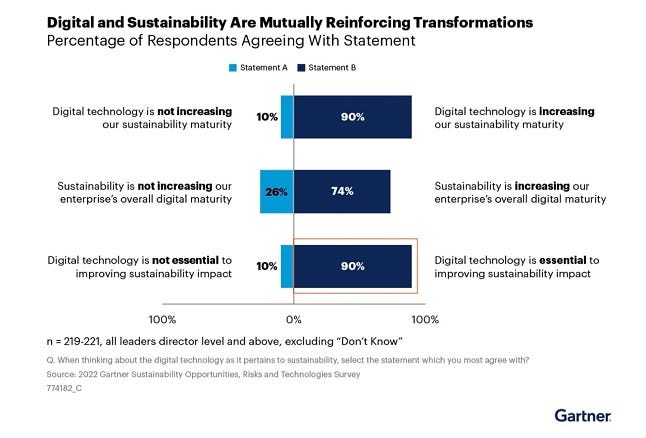Businesses Bloom With Sustainability GainsBusinesses Bloom With Sustainability Gains
Companies that embrace sustainability outperform their peers and achieve higher growth rates and better financial outcomes, according to a growing body of research.

It shouldn’t come as a surprise to anyone that digitally mature companies are better equipped to deal with sustainability issues. Armed with technologies like advanced analytics, machine learning, Internet of Things (IoT), and agile cloud frameworks, they can act on data faster and better than peers.
But digital maturity is not a one-way street. Somewhere at the intersection of profits and brand reputation lies an intriguing fact: Organizations with a strong bent toward sustainability also boost digital maturity -- and unlock greater value. “Many people continue to believe that sustainability is an inhibitor, and the opposite is actually true,” says Autumn Stanish, a principal analyst at Gartner.
The reasons hinge heavily on the fact that sustainable practices drive innovation and create new business opportunities while cutting operational costs and reducing risks. In fact, highly sustainable companies outperform their peers on several key metrics. “Sustainability is an important lever to drive business value,” says Mauricio Bermudez Neubauer, global lead for Carbon Strategy & Intelligence at Accenture.
Performance Matters
Naysayers may cling to the idea that the link between sustainability and digital progress is tenuous. However, the numbers tell a very different story. A landmark study conducted by Deutsche Bank found that 89% of companies with high environmental, social, and governance (ESG) ratings outperform their peers and have a lower overall cost of debt.
Accenture reports that businesses that tilt toward strong sustainability practices report 11% higher innovation levels, 10% higher incremental revenue growth, 13% higher cost-reduction gains and perform 17% better on their balance sheets. They also outperform peers by 32% on sustainability metrics. “These companies actively generate 360 degree value,” Neubauer explains.
As a result, the winds of sustainability are now blowing in an entirely different direction. “We are moving away from a world where sustainability is predominantly anchored in compliance, risk management, and external perception, to a world where sustainability strategy is integrated with companies’ general business strategies,” observes Sean Kane, a partner at McKinsey Sustainability.
When Gartner examined digital maturity and sustainability [see chart below] it found that 90% of respondents to a 2022 survey of business leaders at the director level or above reported that digital technology is contributing to improved sustainability. Yet, at the same time, 74% said that sustainability is boosting overall digital maturity.

Source: Gartner
The same research pointed to clear reasons for this outcome. Overall, 86% of respondents said that sustainability protect their organizations from disruption impacts, 80% indicated that it helps reduce costs and 83% noted that sustainability initiatives fuel innovation and lead to both short-term and long-term value. In other words, sustainable companies are better equipped to endure whatever chaos comes their way.
“There’s a growing recognition that sustainability isn’t simply a strategy related to climate change and environmental factors, it’s actually a key component in running a business well,” Stanish explains.
A Path to Progress
Business leaders are getting the memo. A November 2022 Accenture report found that 84% plan to increase investments in sustainability initiatives by the end of 2022. In addition, 55% are enhancing sustainability data collection across their value chains, 49% are investing in renewable energy sources and transitioning to circular business models, and 40% are investing directly in R&D funding for sustainable innovation.
Optics and economics often shift dramatically as production of a sustainable item or initiative scales up, Stanish says. Sales gains, additional revenue and lower per unit cost structures fuel additional sustainable practices -- and further gains. In fact, McKinsey & Company found that 66% of the public considers sustainability issues when making a purchase. Deloitte reported that 44% of firms with a strong focus on sustainability also enjoy an advantage in recruiting and retaining talent.
Then there’s the fact that when overall societal costs are plugged into the equation a sustainable business model may look very different than a short-term cost model. For instance, the impacts resulting from climate change -- including possible energy shortages and challenges obtaining raw materials -- results in a need to invest more heavily in resilient infrastructure but they also point to a need to develop more predictable sourcing strategies.
For CIOs and others leading the charge, there are some proven ways to approach the challenge. The goal, Neubauer says, is for an organization to possess data and models that illuminate a path to both sustainability and digital progress. This points to a need to identify key material, climate and other sustainability risks and identify a path to a more sustainable and predictable framework. “There’s a need to measure direct impacts and translate them into financial impacts, today and in the future, with scenario analyses and stress tests,” he says.
Gartner recommends focusing on developing strong data-driven insights such as carbon tracking tools, analytics and machine learning. “These provide the proof points needed to guide digital progress,” Stanish says. This approach can also help an organization identify renewable energy and other resources that produce more predictable cost frameworks. It can also aid in developing new organizational skills, methods, and frameworks for promoting sustainability.
A focus on the circular economy is also beneficial, Stanish says. “The ability to create ecosystems that maximize resources -- everything from computing frameworks to waste and recycling -- can have a profound impact on digital innovation and opportunity,” she says. “One of the things that’s often overlooked is the importance of decoupling growth from sourcing. There are many ways for a digital agile company to innovate and grow.”
By the Numbers
Of course, even the shrewdest and most progressive digital leaders won’t see climate and sustainability risks vanish. However, they are better equipped to “recognize new possibilities for value creation and make credible efforts to pursue them,” Kane says. Already, McKinsey is seeing the most successful companies expand sales 50% faster than peers. “Net-zero goals will spur booming demand for climate-friendly goods and services and the green energy, equipment, and infrastructure needed to produce them,” he explains.
To be certain, getting to a more evolved business framework isn’t easy. It requires a focus on building a two-way digital street that intertwines digital technologies and sustainability. It also requires a fundamental reassessment of business and IT -- and a deeper understanding of where value comes from and how to create it. Concludes Stanish: “There’s a growing recognition that sustainable practices fuel business performance. When organizations get the formula right the results are truly impressive.”
What to Read Next:
Can You Measure the True Costs of Being a Data-Driven Business?
4 Big AI Sustainability Prospects, and One Big Problem
What's the Environmental Impact of a Data-Driven Organization?
About the Author
You May Also Like






